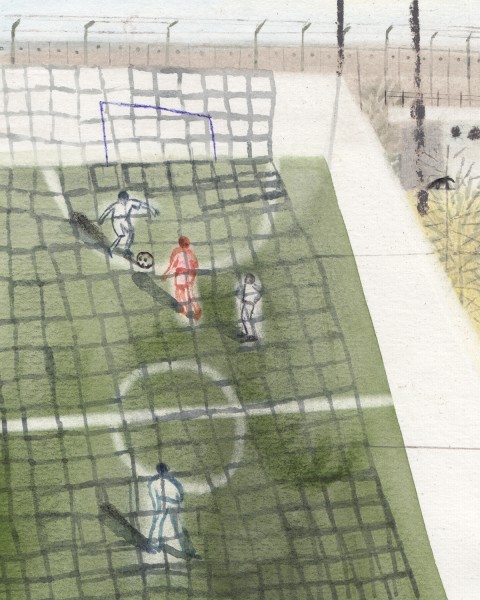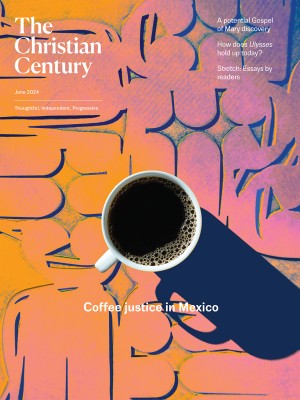Tear gas over the soccer field
“You’re welcome to take it back home with you,” my Palestinian friend said as I looked at the US-made canister in my hand. “Actually, take all of them.”

(Illustration by Laura Carlin)
I have a tear gas canister on my shelf. Already detonated, of course. A friend from the Lajee Center at Aida Camp, a refugee camp just outside Bethlehem, gave it to me during a 2016 visit. We were walking back to the center after lunch. Kids were playing soccer in the quiet road that runs alongside the wall separating olive groves on the other side from cramped housing units on this side, the wall that segregates the state of Israel from the occupied Palestinian territories.
They passed us the ball, which I kicked up to my head, then bounced off my chest and juggled from foot to foot. I soon lost control but managed to pass the ball back before I completely embarrassed myself. We laughed. Then my friend reached to the ground and picked up a cylinder. “Let’s just say you tripped on this,” he joked. I cocked my head, curious about the object. “I assumed you’d know what this is, since it’s from your country,” he said, handing the chunk of metal to me. Despite the gashes and scratches, I could read the blue script circling the canister: 73/38 Riot CS Smoke Multi-Projectile (3) Range – 80 YD (73 Meter).
Read our latest issue or browse back issues.
“This is how they shoot the tear gas at us from up there,” my friend said, pointing to the watchtowers on the massive wall curving around our corner of the refugee neighborhoods—residents call it the apartheid wall. I could see the outline of a man with a gun slung over his shoulder. Israeli soldiers monitor the Palestinian population and sometimes stage incursions into the outskirts of Bethlehem.
I returned my attention to the tear gas canister in my hand and read the rest of the blue script, which advertised the name of the weapons manufacturer, Combined Tactical Systems (now Combined Systems) of Jamestown, Pennsylvania, along with contact information. And, in a large font: Made in U.S.A. “You’re welcome to take it back home with you,” my friend said. “Actually, take all of them.” He pointed to more canisters along the edges of the street, the litter of military occupation.
Later that week I joined the kids on their soccer field at the Lajee Center. As I arrived I heard the children before I saw them—shouts of joy, of delight, of kids at play. Young girls were scrimmaging, and the coach put me on one of the teams. I was no match for their unbounded energy and enthusiasm. But soon I found the ball at my feet and passed it to a teammate near the goal. She put all the power of her seven-year-old body into her leg and launched the ball toward the goal. An unlucky bounce sent her shot just wide of the post, and she plopped to the ground, frustrated. Her friends lifted her up, and we played on. Our team lost, but that didn’t stop us from laughing.
As we played and laughed, I noticed the netting above us—a web stretched from sideline to sideline, suspended in the sky by a skeleton of metal rods. Caught in the net, kept far away from the soccer field below, were more tear gas canisters. During halftime, I asked the coach about the metal cylinders tangled in the mesh. “They shoot them at us from over there,” she said, nodding at the towers and the wall beyond the community garden and playground. She explained that when they first started playing on the field, soldiers would fire tear gas and the canisters would land on the ground, forcing everyone to scatter. Now, with the netting in place, when they shoot the smoke doesn’t take as long to blow away.
According to the Council on Foreign Relations, US aid to Israel averages $3.3 billion a year—of which 99 percent is military aid. Like for the tear gas. And for those fighter jets flying over Gaza, bombing cities and killing tens of thousands. For decades, Israeli military officials and pundits have referred to their anti-Hamas tactics in Gaza as “mowing the grass”—restrained operations, they’ve claimed, with surgical destruction. “This is constant, hard work,” a national security strategist wrote in the Jerusalem Post in 2021. “If you fail to do so, weeds grow wild and snakes begin to slither around in the bush.” Again and again this metaphor has been invoked as justification for Israel’s military invasions of Gaza: mow the grass.
After our halftime break, the coach blew a whistle and we took our positions, with grass under our feet and signs of warfare above our heads. To grow up in Aida Camp, I learned, is to live in a militarized valley of death, shadowed by soldiers on walls. Palestinian life can’t escape the panoptic stare of the Israeli surveillance state, nor is there any respite from the threat of an army ready to disrupt the goings-on of a refugee city without warning. But the children still play soccer. Toddlers still run around and around the swing set next to the field. And the mothers in hijabs laugh together as they watch from the shade of olive trees.
“Existence is resistance,” a friend from Bethlehem told me when I recounted my experience at Aida Camp. The first time I heard that saying was in At-Tuwani—a Palestinian village with ancient origins, near the Israeli outpost settlement of Havat Ma’on—where two women gave me a tour of their vegetable garden. “We plant, we eat, we hope,” one said. The other added, “Our existence is our resistance.”
The ongoing existence of Palestinian life is resistance against the destruction that we in the United States have funded. On the edge of violence, always under threat, Palestinians try to stay alive. Like children at play—joy as resistance. Like gardeners tending to olives and almonds and cabbages and beans—the beauty of life. We believe in the gospel of life.






